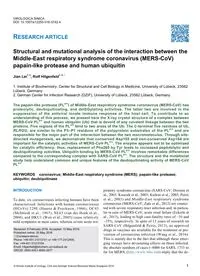
2016 Structural and mutational analysis of the interaction between the Middle-East respiratory syndrome coronavirus (MER PDF
Preview 2016 Structural and mutational analysis of the interaction between the Middle-East respiratory syndrome coronavirus (MER
VIROLOGICA SINICA DOI: 10.1007/s12250-016-3742-4 RESEARCH ARTICLE Structural and mutational analysis of the interaction between the Middle-East respiratory syndrome coronavirus (MERS-CoV) papain-like protease and human ubiquitin Jian Lei 1, 2, Rolf Hilgenfeld 1, 2* 1. Institute of Biochemistry, Center for Structural and Cell Biology in Medicine, University of Lübeck, 23562 Lübeck, Germany 2. German Center for Infection Research (DZIF), University of Lübeck, 23562 Lübeck, Germany The papain-like protease (PL pro) of Middle-East respiratory syndrome coronavirus (MERS-CoV) has proteolytic, deubiquitinating, and deISGylating activities. The latter two are involved in the suppression of the antiviral innate immune response of the host cell. To contribute to an understanding of this process, we present here the X-ray crystal structure of a complex between MERS-CoV PL pro and human ubiquitin (Ub) that is devoid of any covalent linkage between the two proteins. Five regions of the PL pro bind to two areas of the Ub. The C-terminal five residues of Ub, RLRGG, are similar to the P5–P1 residues of the polyprotein substrates of the PL pro and are responsible for the major part of the interaction between the two macromolecules. Through site- directed mutagenesis, we demonstrate that conserved Asp165 and non-conserved Asp164 are important for the catalytic activities of MERS-CoV PL pro. The enzyme appears not to be optimized for catalytic efficiency; thus, replacement of Phe269 by Tyr leads to increased peptidolytic and deubiquitinating activities. Ubiquitin binding by MERS-CoV PL pro involves remarkable differences compared to the corresponding complex with SARS-CoV PL pro. The structure and the mutational study help understand common and unique features of the deubiquitinating activity of MERS-CoV PL pro. KEYWORDS coronavirus; Middle-East respiratory syndrome (MERS); papain-like protease; ubiquitin; deubiquitinase INTRODUCTION To date, six coronaviruses infecting humans have been characterized. Infections with human coronaviruses (HCoVs) 229E (Hamre & Procknow, 1966), OC43 (McIntosh et al., 1967), NL63 (van der Hoek et al., 2004), and HKU1 (Woo et al., 2005) cause relatively mild symptoms in most cases, whereas severe acute res- piratory syndrome coronavirus (SARS-CoV; Drosten et al., 2003; Ksiazek et al., 2003; Kuiken et al., 2003; Peiris et al., 2003) and Middle-East respiratory syndrome coronavirus (MERS-CoV; Zaki et al., 2012) are connec- ted with severe respiratory-tract infection and, in particu- lar in case of MERS-CoV, acute renal failure (Eckerle et al., 2013), leading to high case-fatality rates of ~10 and ~35%, respectively. In spite of 13 years of research on SARS-CoV (Hilgenfeld & Peiris, 2013), no approved drugs or vaccines are available for the treatment or pre- vention of coronavirus infection (Wang et al., 2016). This is mainly due to the fact that although these emer- ging viruses have devastating effects on those infected, the absolute numbers of cases (~8000 for SARS, 1733 so far for MERS; (http://www.who.int)) imply that the de- Received: 8 February 2016, Accepted: 10 May 2016, Published online: 30 May 2016 *Correspondence: Phone: +49-451-31013101 or +49-177-2412455, Fax: +49-451-31013104 Email:
